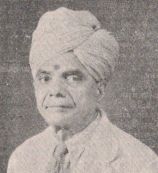எஃப். ஜி. நடேச ஐயர்
எஃப். ஜி. நடேச ஐயர் (F. G. Natesa Iyer, 11 நவம்பர் 1880 – 23 சனவரி 1963) இந்திய தேசியக் காங்கிரசில் செயற்பட்ட ஒரு விடுதலைப் போராட்ட வீரர் ஆவார். நவீன தமிழ் நாடகம், தமிழ்த் திரைப்படத்துறையின் முன்னோடிகளில் ஒருவராகத் திகழ்ந்தார். இவர் ஒரு திறமையான ஆசிரியரும் ஆவார், பல இளைஞர்களது தகுதியை அங்கீகரித்து, ஊக்குவித்தார். இவரது மாணவர்கள் பின்நாட்களில் கர்நாடக இசையில் சிறந்த கலைஞர்களாக மாறினர்.
எஃப். ஜி. நடேச ஐயர் | |
|---|---|
 | |
| பிறப்பு | 11 நவம்பர் 1880 புதுக்கோட்டை, புதுக்கோட்டை சமஸ்தானம், இந்தியா |
| இறப்பு | 23 சனவரி 1963 (அகவை 82) போபால், மத்தியப் பிரதேசம், இந்தியா |
| தேசியம் | இந்தியர் |
| அறியப்படுவது | 'ரசிக ரஞ்சன சபா' நிறுவனர் |
ஆரம்ப வாழ்க்கை மற்றும் பின்னணி
தொகுநடேச ஐயர் 1880 நவம்பர் 11 அன்று, ஜானகியம்மையார் (புதுக்கோட்டம்மா), கங்காதர சாஸ்திரி ஆகியோருக்கு மகனாகப் பிறந்தார். கங்காதர சாத்திரி அப்போது பிரித்தானியக் குடியேற்ற ஆட்சியின் கீழ் இந்தியத் துணைக்கண்டத்தின் புதுக்கோட்டை மாநிலத்தின் சட்ட ஆலோசகராக இருந்தார். நடேச ஐயரின் மூத்த சகோதரர் ராவ் சாகிப் ஜி. கணபதி சாஸ்திரி புதுக்கோட்டை மாநிலத்தின் திவானாக இருந்தவர். இவரது குடும்பம் அப்பய்யா தீட்சிதர் பரம்பரையைச் சேர்ந்தது.[1] நடேச ஐயர் இசை, நாடகம் மீதான ஈர்ப்பினால் பத்து வயதில் வீட்டை விட்டு சென்றார். மதுரா, திண்ணைவேலி - குயிலான் தொடருந்துக் கட்டுமானத் துறையில் ஒரு எழுத்தராக சேர்ந்தார்.[2]
நடிகர்
தொகுநடேச ஐயர் 1938-இல் கே. சுப்பிரமணியம் இயக்கத்தில் வெளிவந்த சேவாசதனம் திரைப்படத்தில் கதாநாயகனாக நடித்தார். ஐயர் இதில் "ஈசுவர ஐயர்" என்ற பாத்திரத்தில் நடித்தார். ம. ச. சுப்புலட்சுமி "சுமதி" என்ற பாத்திரத்தில் நடித்தார். சமூக சீர்திருத்தங்களுக்காக இத்திரைப்படம் பிரபலமானது. மூத்த மார்க்சியத் தலைவர் என். சங்கரய்யா, இத்திரைப்படத்தை இளம் பெண்களுக்கும், வயதான ஆண்களுக்கும் இடையிலான திருமணத்தைத் தேர்ந்தெடுக்கும் ஒரு "அசாதாரணப் படம்" என்று விவரித்தார். முதியவர் வேடத்தில் ஐயரின் நடிப்பை சங்கரய்யா குறிப்பாக பாராட்டினார்.[3]
பொது வாழ்க்கை
தொகுஐயர் தென்னிந்திய ரயில்வே நிறுவனத்தில் (எஸ்ஐ ஆர்) ரயில்வே அதிகாரியாக இருந்தார். இவர் 1935 இல் மாவட்டப் போக்குவரத்து கண்காணிப்பாளராக ஓய்வு பெற்றார். இந்தப் பதவியை வகித்த முதல் இந்தியர் இவர் ஆவார்.[சான்று தேவை] தென்னிந்திய ரயில்வேயின் நிர்வாக தலைமையகம் திருச்சிராப்பள்ளியில் இருந்தது. ஐயர் தனது வாழ்க்கையின் பெரும்பகுதி திருச்சியில் வாழ்ந்தார்.
தனிப்பட்ட நம்பிக்கை
தொகுஇரமண மகரிசியுடனும், அவரது ஆசிரமத்துடனும் நடேச ஐயர் மிகுந்த உளத் தொடர்பு கொண்டிருந்தார்.[4] [5] சிவானந்த சரஸ்வதியின் அபிமானியாகவும் இருந்தார். இவர் எழுதிய அஞ்சலிக்குறிப்பு தெய்வீக வாழ்க்கை சங்கத்தின் ஓரு வெளியீட்டில் வெளியானது.[6]
ஐயர், தமிழ்ப் பிராமண சமூகத்தின் வடமா துணைப் பிரிவின் ஸ்மார்த்தப் பாரம்பரியத்தைச் சேர்ந்தவர் என்று அனுமானிக்கப்படலாம் . இவர்கள் அத்வைத வேதாந்தத்தை அடிப்படையாகக் கொண்டிருந்தனர்.
மறைவு
தொகுநடேச ஐயர் 1963 சனவரியில் போபாலில் உள்ள அவரது மகள் திரிபுரசுந்தரியின் வீட்டில் தனது 82-வது அகவையில் மறைந்தார். இவரது உடல் போபாலில் இராணுவ மரியாதையுடன் தகனம் செய்யப்பட்டது.
மேற்கோள்கள்
தொகு- ↑ SUGANTHY KRISHNAMACHARI (30 January 2014). "A century of service". The Hindu. http://www.thehindu.com/features/friday-review/history-and-culture/a-century-of-service/article5634468.ece. "Tiruchi's R. R. Sabha, which turns 100 this year, has been fostering the cause of charity and culture. In 1915 at the Trichinopoly Collector’s bungalow, Sheridan’s play ‘Pizzaro’ was enacted in aid of the Ladies’ War Fund. The predominantly British audience was amazed at the excellent diction of the all Tamil cast. In 1918, two plays were staged as part of the peace celebrations organised by the Carnatic Infantry. In 1918, “At Home” was given to Mr. Blackstone, Deputy Superintendent of Police and the same drama troupe presented a few plays. The troupe staged benefit shows to raise funds for the Manicka Vinayakar temple. The theatre enthusiasts, munificent in their contributions to charitable causes, were all members of the Rasika Ranjana Sabha (RRS), Tiruchi. RRS was inaugurated at a meeting held in the Tiruchi Fort Railway Museum, on November 9, 1914, with Kodiyalam Rangaswamy Iyengar as the first president. The membership fee was eight annas per month. To start with, the sabha had 25 members. Within a year, the number increased to 153. Zamindar of Andipatti, Mc.T. Pethachi Chettiar, Dewan Bahadur T. Desikachariar, Advocate, and G.K. Rengil Doss were among the generous donors to the sabha in the early years. The founder members were men of varied talents. S.S. Subramania Iyer, for instance, wrote two songs for the sabha, ‘Gandhi vakyam’ to be sung before the commencement of any programme, and mangalam to mark the conclusion. The first secretary of the sabha, F.G. Natesa Iyer, popularly known as FGN, belonged to the lineage of Appayya Dikshitar, and his grandfather and father were accomplished veena players."
- ↑ F.G. Natesa Iyer [330] - $.5.00 : Sruti, A Monthly Magazine on Indian Performing Arts பரணிடப்பட்டது 3 பெப்பிரவரி 2013 at Archive.today
- ↑ Vishwanathan S. "A progressive film maker; Tribute to K. Subramanian", Volume 21 - Issue 14, 3-16 July 2004 of Frontline magazine, (brought out by Hindu publications), Chennai, Tamilnadu. பரணிடப்பட்டது 17 அக்டோபர் 2006 at the வந்தவழி இயந்திரம்
- ↑ Sri Ramanasramam Charities (1979). "Mountain Path". Mountain Path (Sri Ramanasramam) 16: 177. https://books.google.com/books?id=pQTXAAAAMAAJ&q=F+G+Natesa+Iyer. பார்த்த நாள்: 3 July 2013.
- ↑ Sri Ramanasramam Charities (1983). "Mountain Path". Mountain Path (Sri Ramanasramam) 20: 286. https://books.google.com/books?id=ZQfXAAAAMAAJ&q=FG+Natesa+Iyer. பார்த்த நாள்: 16 July 2013.
- ↑ SIVANANDA: HIS MISSION AND MESSAGE. The divine life society. 1952. p. 419. பார்க்கப்பட்ட நாள் 8 September 2015.